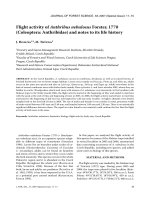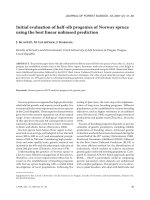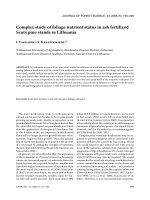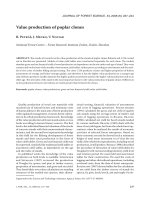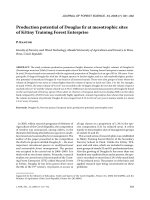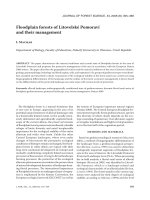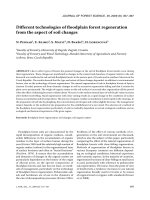Báo cáo lâm nghiệp: "Initial evaluation of half-sib progenies of Norway spruce using the best line" potx
Bạn đang xem bản rút gọn của tài liệu. Xem và tải ngay bản đầy đủ của tài liệu tại đây (525.6 KB, 6 trang )
J. FOR. SCI., 53, 2007 (2): 41–46 41
JOURNAL OF FOREST SCIENCE, 53, 2007 (2): 41–46
Norway spruce is recognized for high productivity,
relatively fast growth, and superior wood quality. It is
economically the most important forest tree species
in the Czech Republic. ese superior characteristics
gave rise to the massive expansion out of its natural
range. Some omission of biological requirements
of this species in the past led consequently to more
expensive aforestation costs due to lower resistance
to biotic and abiotic factors (B 2004).
Norway spruce from Sázava River region is char-
acterized as an ecotype well adapted to low elevated
areas (300 to 500 m a.s.l.) and atmospheric precipi-
tation of 500 to 700 mm. Considering high produc-
tivity and some quality traits, genetic research was
initiated in the 60’s with the phenotypic selection of
about 200 plus trees (Ž, M 1978).
Understanding the genetics of Norway spruce is
a key to more efficient management of this species.
erefore, a lot of tree improvement effort has fo-
cused on the establishment of breeding programs
with Norway spruce beginning with a careful initial
investigation of local populations. Following the
testing of plus trees, the next step is the implemen-
tation of long-term breeding programs. Different
populations can be established for various breeding
objectives, such as higher resistance in air-polluted
areas (H et al. 1992) or general improvement of
productivity and quality traits (Ž, M
1978).
Success of breeding programs depends on precise
estimates of genetic parameters, including reliable
predictions of breeding values. Advanced genetic
evaluation methods have been developed during the
second half of the 20
th
century (H 1988).
Restricted Maximum Likelihood (REML) followed
by the Best Linear Unbiased Prediction (BLUP) is
the most efficient method for the identification of
individuals, which enables to achieve maximum
genetic gain in selected breeding populations. Com-
pared to classical ANOVA based approach, general
REML – BLUP is particularly useful in computing
genetic parameters when datasets are unbalanced
with complex pedigrees. is property is very attrac-
tive to plant breeders, who deal with field trials and
Supported by the Czech University of Life Sciences in Prague, Faculty of Forestry and Environment, Project No.
41130/1312/413162.
Initial evaluation of half-sib progenies of Norway spruce
using the best linear unbiased prediction
J. K, M. L, J. K
Faculty of Forestry and Environment, Czech University of Life Sciences in Prague, Prague,
Czech Republic
ABSTRACT: e present paper deals with data obtained from fifteen years old Norway spruce (Picea abies [L.] Karst.)
progeny test established at three sites in the Sázava River region. Parameter under the evaluation was a tree height in
15 years following the establishment of the trial. Genetic parameters were estimated using the REML (Restricted Maxi-
mum Likelihood) procedure followed by the BLUP (Best Linear Unbiased Prediction). Genetic parameters estimates
were used to predict genetic gain in three alternative selection strategies. e value of gain depends on target value of
gene diversity. 10–15% gain is due to selecting breeding population composed of 50 individuals. Based on these quan-
titative findings, current and future research orientation is discussed.
Keywords: Norway spruce; BLUP analysis; progeny test; genetic gain
42 J. FOR. SCI., 53, 2007 (2): 41–46
search for the most efficient solution to compensate
both mortality and field heterogeneity in statistical
models. Principle of REML – BLUP procedure lies
in iterative maximization of a likelihood function
to estimate genetic variances through REML that
are then employed by BLUP procedures in order to
predict individual breeding values (L, W
1998).
Classical progeny trials are established as regular
field experiments. Under ideal situations, the ex-
periment is replicated in independent blocks that
are completely homogeneous. In reality, experiments
deviate from this ideal situation and often, breeders
are faced with complications that require adjust-
ments in statistical analyses. Added precision in
genetic trials can be achieved through neighbor
adjustments based on calculating the experimental
variance as a function of distances and fitting these
with theoretical models (J et al. 2002) or taking
other covariables into the model (A, S
1998).
Prediction of breeding values is a prerequisite to
successful implementation of long-term breeding
programs. Breeding values are utilized during the
selection of future breeding and production popula-
tions side by side with the development of long-term
breeding plans. e first evaluation of progeny tests
is revisited in this study. Breeding values are predict-
ed for both original plus trees and their individual
half-sib progenies. New evaluation of these tests will
be performed in the late summer of 2006. Following
the updated assessment, selection will be performed
and the long-term breeding programs proposed. e
second goal of this study is to predict genetic gain
from the first round of selection.
MATERIAL AND METHODS
Field experiments
The field trial was established in 1975 with
4-years-old seedlings planted in spacing of 1.5 × 2 m.
Seedlings are half-sib progenies originated from
open-pollination of superior trees selected based
on phenotypic assessment in 12 local populations
within the Sázava River area (Fig. 1). e seed was
collected during an abundant seed crop in 1971 and
sown at Truba Breeding Station of the Forestry Re-
search Institute in Kostelec nad Černými lesy. e
field trial was designed as a randomized block design
(RBD) with 3 to 4 blocks per each site. On average,
120 half-sib families were tested at each site. Each
family was originally represented by 15 to 17 seed-
lings per each plot. Progeny tests are located at the
School Forest Enterprise district. e trait measured
was a height in 15 years of age.
Data diagnostics
All original datasets were tested for key departures
from model assumptions with diagnostic tools avail-
able in SAS software package (SAS Institute Inc.
1996). Out of these assumptions, the homogeneity of
variance was found problematic in one block (#3) at
the Mostice site. e dataset Mostice was therefore
modified and the problematic block was excluded
due to its large contribution to the whole-site het-
erogeneity of variance. As noted by N et al.
(1996), if an entire block needs to be dropped from
the analysis (due to spoiled results), the analysis is
not complicated thereby.
Fig. 1. Superior plus trees were selected
within the 12 locations (11 shown on the
map)
1 – Dolánka, 2 – Jevanské údolí, 3 – Pod
Aldašínem, 4 – Komorce, 5 – Údolí Ča-
kovického potoka, 6 – Šiberna, 7 – Dub-
sko, 8 – Český Šternberk, 9 – Stará huť,
10 – Hodkovské údolí, 11 – Roztěž, 12 – Psá-
ře (out of the map)
J. FOR. SCI., 53, 2007 (2): 41–46 43
e general statistical model
Mixed linear model implemented in this study is
of the following general form:
Y = Xβ + Zu + e (1)
where: Y – n × 1 vector of observations,
X – n × p design matrix for fixed effects,
β – p × 1 vector of fixed effects,
Z – n × q design matrix for a q × 1 vector of random
effects u ~ N(0, G),
e ~ N(0, R) – n × 1 vector for residuals,
and
u G 0
Var
[
]
=
[
]
σ
2
(2)
e 0 R
where: G and R – positive definite variance-covarinace ma-
trices,
σ
2
– positive constant.
Consequently, Y is n × 1 vector of observations and
it is assumed to be distributed:
Y ~ N(Xβ, R + ZGZ’) (3)
Estimation of G and R matrices through
the Restricted Maximum Likelihood (REML)
Variance components (G and R matrices) are esti-
mated iteratively by restrictive version of the maxi-
mum likelihood method. e procedure searches for
parameters of the distribution to provide the best
fit to the observed values. Compared to maximum
likelihood, REML method is restricted to the random
component of the model. REML procedure consists
of a search through the entire range of parameter
space and the computation of the log-likelihood for
each parameter value across the range. e solu-
tion is given by achieving the largest log-likelihood
(L, W 1998).
Best Linear Unbiased Prediction (BLUP)
Given the observed (phenotypic) values in the Y
vector, and estimates of G and R, the BLUP proce-
dure provides the best linear unbiased estimator
(β
ˆ
) of β and the best linear unbiased predictor (uˆ ) of
u. e predictors are solutions to the mixed-model
equations and have important statistical properties.
First, they are linearly related to the observations in
Y. Second, they are unbiased in the sense that the
average value of the estimate (with respect to the
distribution of Y) is equal to the expected value of
the quantities being estimated, and third, they are
the best in the sense of having the minimum mean
square error within the class of all linear unbiased
estimates (M 1996). β
ˆ
and uˆ are calculated
from the following mixed-model equations:
X´R
–1
X X´R
–1
Z β
^
X´R
–1
Y
[
]
[
]
=
[
]
(4)
Z´R
–1
X Z´R
–1
Z + G
µ
^
Z´R
–1
Y
Experimental design
e modeling approach utilized in this study as-
sumed the original randomized block design scheme
with random replicates of the experiments (blocks)
and fixed experimental sites. Sites were analyzed
simultaneously using the ASReml
®
software package
(G et al. 2002) in order to predict breeding
values across all locations.
Prediction of genetic response to selection
Given the estimates of genetic parameters, it is
possible to predict genetic response under vari-
able selection intensity. Two alternative selection
scenarios were considered. In the first alternative, it
was assumed that the top plus trees will be selected
based on the performance of their half-sib progenies
(classical evaluation of parents based on an open-
pollinated progeny test followed by selection of the
best parents). Equations were derived from L-
and W (1989) and some modifications
were made for the current study. Genetic response
to selection (R
1
) was calculated as follows:
0.5 σ
A
R
1
= i ———————————— (5)
√ 0.25 σ
A
2
+ (0.75 σ
A
2
+ σ
E
2
)/m
where: i – selection intensity,
σ
A
2
– additive genetic variance,
σ
E
2
– environmental variance,
m – family size (number of half-sib progenies
per each plus tree).
In the second alternative, forward selection of the
best half-sib progenies was assumed. e response
to selection (R
2
) under this scheme was:
R
2
= i
f
r
A1
+ i
w
r
A2
(6)
where: i
f
– selection intensity due to selection of the best
families,
i
w
– selection intensity due to within-family selec-
tion,
r
A1
and r
A2
– corresponding correlations between the
true additive genetic value and the selection
criterion.
ese are calculated as follows:
σ
A
(0.25 + 0.75/m)
r
A1
= ———————————— (7)
√ 0.25 σ
A
2
+ (0.75 σ
A
2
+ σ
E
2
)/m
0.75(1 – 1/m) σ
A
r
A2
= ————————————
√ 0.75 σ
A
2
+ (1 – 1/m)+ σ
E
2
44 J. FOR. SCI., 53, 2007 (2): 41–46
To make the comparison fair, total size of the
progeny trial was fixed at 2,368 trees. Number of
plus trees (N) and family size (m) were then subject
to the following restriction:
N × m = 2,368 (8)
Integer values were rounded in order to satisfy
their biological meaning. Finally, under the third
alternative, the environmental variance in Equation
(7) was divided by the number of clonal replicates.
is assumes clonal replication of half-sib progenies
and the corresponding response is denoted as R
3
.
RESULTS AND DISCUSSION
e estimated narrow-sense heritability was 0.269
with a standard error of 0.036, which resembles gen-
eraly to other findings in the literature for Norway
spruce growth traits, e.g. J et al. (2002) and
R (1999). Predicted BLUP values of indi-
vidual plus trees are presented by the localities of
their origin in Fig. 2 (compare localities to Fig. 1). e
greatest potential for backward selection is within
the locations 4, 10, 7, and 8. Few superior trees were
also available in locations 1, 9, 5, and 12. It was not
practical to present here individual BLUP values
for all progeny genotypes; full list of values can be
obtained from the corresponding author.
Fortunately, the distribution of BLUP values
among half-sib progenies offers greater potential for
selection within families due to Mendelian sampling
of alleles, which is a source of significant additive
variance (F, M 1996). Due to this
build-up of genetic variance, it is possible to find
superior progeny genotypes within a large share of
the tested families. erefore, one may assume bal-
anced within-family selection to capture sufficient
amount of diversity to initiate the breeding popula-
tion, while attaining sufficient genetic gain due to
intensive within-family selection.
Response to selection
Genetic parameters estimated through the REML
procedure entered the genetic gain calculation. Ge-
netic gain is presented for the three alternatives in
Fig. 3. Approximately 10% genetic gain (thick line) is
attributable to breeding population established from
the 50 best plus trees. Higher gain (up to 15%, thin
line) is available due to selecting single genotypes
out of 50 top-ranking half-sib families. Other selec-
tion options are available; this is just a demonstra-
tion of the genetic potential in the current progeny
trial. Higher gains are associated with lower gene
diversity; therefore a large range of diversity values
is presented in Fig. 3 (effective population size,
x axis). Selecting very large breeding or production
populations results in considerably lower gains;
which holds particularly under backward selection
of the original plus trees (R
1
line). e third line
(dotted) in the figure indicates potential gain that
would become available under clonal replication
of the progeny trial. is is a theoretical value for
comparison; vegetative propagation was not utilized
during the trial’s establishment. e extra additive
genetic value due to clonal replication was limited
by assuming constant size of the experiment; line
R
3
corresponds to 7 ramets per clone assuming that
number of clones per family × number of ramets
was equal to the average family size under R
1
and R
2
.
Higher genetic gain would be available in the absence
of this restriction.
Initial evaluation of the open-pollinated progeny
trial points to a relatively standard magnitude of ge-
netic gain as expected from the first breeding cycle
– refer e.g. to Z and T (1984) or
L et al.
(1999). Large number of tested plus trees and half-
sib families provides an ample potential for selection
in the area of the Sázava River region and for the
initiation of the long-term breeding program in the
same region. e next step is the second evaluation
Fig. 2. Best linear unbiased pre-
dictions of plus trees sorted by
their origin (see Fig. 1 for the
physical distribution of locations
on the map)
J. FOR. SCI., 53, 2007 (2): 41–46 45
of the experiment based on measurements in the late
summer of 2006. Higher number of traits (quanti-
tative, qualitative) is recorded per each tree. More
elaborate data analysis will be performed combin-
ing multiple traits into a single selection criterion.
Alternative breeding strategies will be proposed to
the School Forest Enterprise (ranging from low-cost
to more expensive ones) along with thorough evalu-
ation of the economic return of investment. e
plan will also focus on the fast delivery of genetic
gain into newly planted stands through production
populations to solve current seed demands side by
side with the development of long-term breeding
program.
Ac k no wl e dg e me nt s
We thank to Dr. G D for his valu-
able advice.
R ef er en ces
ANAND J., SADANA D.K., 1998. A comparison of herit-
ability estimates obtained from least-squares ANOVA
and REML methods. Indian Journal of Animal Science,
68: 942–945.
BEZNOSKA K., 2004. Smrk ztepilý dřevina roku 2004. Lesu
zdar, 10: 6–8.
FALCONER D.S., MACKAY T.F.C., 1996. Introduction
to Quantitative Genetics. 4
th
ed. New York, Longman:
464.
GILMOUR A.R., GOGEL B.J., CULLIS B.R., WELHAM S.J.,
THOMPSON R., 2002. ASReml User Guide Release 1.0 VSN
International Ltd., Hemel Hempstead, HP1 1ES.
HENDERSON C.R., 1988. Progress in statistical methods
applied to quantitative genetics since 1976. In: WEIR
B.S., EISEN E.J., GOODMAN M.M., NAMKOONG G.
(eds.), Proceedings of the Second International Confer-
ence on Quantitative Genetics. Sinauer Associates, MA:
85–90.
HYNEK V., MACHOVIČOVÁ M., DUDA J., 1992. Šlechtitelské
programy pro smrk ztepilý a buk lesní z oblasti Jizerských
hor. Lesnická práce, 71: 181–186.
JOYCE D., FORD R., FU Y.B., 2002. Spatial patterns of tree
height variations in a Black spruce farm-field progeny test
and neighbors-adjusted estimations of genetic parameters.
Silvae Genetica, 51: 13–18.
LI B., McKEAND S., WEIR R., 1999. Tree improvement and
sustainable forestry – impact of two cycles of loblolly pine
breeding in the U.S.A. Forest Genetics, 6: 229–234.
LINDGREN D., WERNER M., 1989. Gain generating ef-
ficiency of different Norway spruce seed orchard designs.
Includes an appendix by Öje Danell. In: STENER L.G.,
WERNER M. (eds.), Norway Spruce: Provenances, Breeding
and Genetic Conservation. Institutet for skogsforbättring,
Rapport 11: 189–206.
LYNCH M., WALSH B., 1998. Genetics and Analysis of Quan-
titative Traits. Sinauer Associates, Inc., MA: 971.
LITTELL R.C., MILLIKEN G.A., STROUP W.W., WOLFIN-
GER R.D., 1996. SAS
©
System for Mixed Models. Cary, NC:
SAS Institute Inc.: 633.
MRODE R.A., 1996. Linear Models for the Prediction of Ani-
mal Breeding Values. Wallingford, CAB International.
NETER J., KUTNER M.H., WASSERMAN W., NACHTS-
HEIM CH.J., 1996. Applied Linear Statistical Models.
4
th
ed. McGraw-Hill, Irwin.
ROSVALL O., 1999. Enhancing gain from long-term forest
tree breeding while conserving genetic diversity. [Ph.D.
esis.] Acta Universitatis Agriculturae Sueciae Silvestria,
109: 65.
ZOBEL B., TALBERT J., 1984. Applied Forest Tree Improve-
ment. New York, John Wiley & Sons Inc.: 505.
ŽĎÁRSKÁ D., MACHEK J., 1978. Šlechtění smrku v Posá-
zaví na základě výběru kvalitních jedinců. In: Sborník
vědeckého lesnického ústavu VŠZ v Praze 21/1978.
Praha, SZN.
Received for publication July 18, 2006
Accepted after corrections September 18, 2006
Fig. 3. Response to selection
of the best plus trees based on
the performance of their half-
sib progenies (R
1
); response to
selection of the best half-sib
progenies (R
2
); response to
selection of the best clonally
replicated half-sib progenies
(R
3
)
R
3
R
1
R
2
46 J. FOR. SCI., 53, 2007 (2): 41–46
Prvotní vyhodnocení polosesterských testů potomstev smrku ztepilého
s využitím analýzy BLUP
ABSTRAKT: Příspěvek slouží jako prvotní hodnocení polosesterských potomstev smrku ztepilého (Picea abies
[L.] Karst.), založených na třech stanovištích v oblasti Posázaví. Hodnoceným parametrem byla celková výška
v patnácti letech od založení experimentu. Genetické parametry byly odhadnuty metodou REML (Restricted Maxi-
mum Likelihood) a individuální šlechtitelské hodnoty metodou BLUP (Best Linear Unbiased Prediction). Odhady
genetických parametrů byly využity pro predikci genetického zisku v případě tří alternativních selekčních strategií.
Hodnota genetického zisku je závislá na cílové hodnotě genové diverzity. Lze očekávat 10–15% zisk na základě selek-
ce šlechtitelské populace o velikosti 50 jedinců. Na základě kvantitativních výstupů je proveden návrh současných
a budoucích výzkumných aktivit.
Klíčová slova: smrk ztepilý; analýza BLUP; test potomstev; genetický zisk
Corresponding author:
Ing. J K, Česká zemědělská univerzita v Praze, Fakulta lesnická a environmentální, katedra
dendrologie a šlechtění lesních dřevin, 165 21 Praha 6-Suchdol, Česká republika
tel.: + 420 224 383 406, fax: + 420 234 381 860, e-mail: klapste@fle.czu.cz
